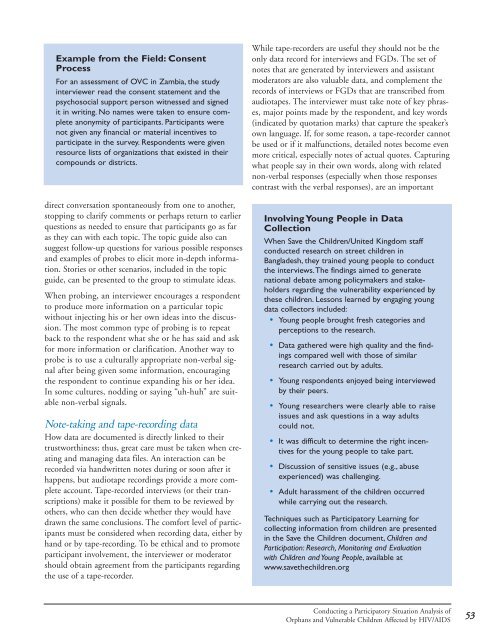Conducting a Participatory Situation Analysis of.pdf - Global HIV ...
Conducting a Participatory Situation Analysis of.pdf - Global HIV ...
Conducting a Participatory Situation Analysis of.pdf - Global HIV ...
You also want an ePaper? Increase the reach of your titles
YUMPU automatically turns print PDFs into web optimized ePapers that Google loves.
Example from the Field: Consent<br />
Process<br />
For an assessment <strong>of</strong> OVC in Zambia, the study<br />
interviewer read the consent statement and the<br />
psychosocial support person witnessed and signed<br />
it in writing. No names were taken to ensure complete<br />
anonymity <strong>of</strong> participants. Participants were<br />
not given any financial or material incentives to<br />
participate in the survey. Respondents were given<br />
resource lists <strong>of</strong> organizations that existed in their<br />
compounds or districts.<br />
direct conversation spontaneously from one to another,<br />
stopping to clarify comments or perhaps return to earlier<br />
questions as needed to ensure that participants go as far<br />
as they can with each topic. The topic guide also can<br />
suggest follow-up questions for various possible responses<br />
and examples <strong>of</strong> probes to elicit more in-depth information.<br />
Stories or other scenarios, included in the topic<br />
guide, can be presented to the group to stimulate ideas.<br />
When probing, an interviewer encourages a respondent<br />
to produce more information on a particular topic<br />
without injecting his or her own ideas into the discussion.<br />
The most common type <strong>of</strong> probing is to repeat<br />
back to the respondent what she or he has said and ask<br />
for more information or clarification. Another way to<br />
probe is to use a culturally appropriate non-verbal signal<br />
after being given some information, encouraging<br />
the respondent to continue expanding his or her idea.<br />
In some cultures, nodding or saying “uh-huh” are suitable<br />
non-verbal signals.<br />
Note-taking and tape-recording data<br />
How data are documented is directly linked to their<br />
trustworthiness; thus, great care must be taken when creating<br />
and managing data files. An interaction can be<br />
recorded via handwritten notes during or soon after it<br />
happens, but audiotape recordings provide a more complete<br />
account. Tape-recorded interviews (or their transcriptions)<br />
make it possible for them to be reviewed by<br />
others, who can then decide whether they would have<br />
drawn the same conclusions. The comfort level <strong>of</strong> participants<br />
must be considered when recording data, either by<br />
hand or by tape-recording. To be ethical and to promote<br />
participant involvement, the interviewer or moderator<br />
should obtain agreement from the participants regarding<br />
the use <strong>of</strong> a tape-recorder.<br />
While tape-recorders are useful they should not be the<br />
only data record for interviews and FGDs. The set <strong>of</strong><br />
notes that are generated by interviewers and assistant<br />
moderators are also valuable data, and complement the<br />
records <strong>of</strong> interviews or FGDs that are transcribed from<br />
audiotapes. The interviewer must take note <strong>of</strong> key phrases,<br />
major points made by the respondent, and key words<br />
(indicated by quotation marks) that capture the speaker’s<br />
own language. If, for some reason, a tape-recorder cannot<br />
be used or if it malfunctions, detailed notes become even<br />
more critical, especially notes <strong>of</strong> actual quotes. Capturing<br />
what people say in their own words, along with related<br />
non-verbal responses (especially when those responses<br />
contrast with the verbal responses), are an important<br />
Involving Young People in Data<br />
Collection<br />
When Save the Children/United Kingdom staff<br />
conducted research on street children in<br />
Bangladesh, they trained young people to conduct<br />
the interviews.The findings aimed to generate<br />
national debate among policymakers and stakeholders<br />
regarding the vulnerability experienced by<br />
these children. Lessons learned by engaging young<br />
data collectors included:<br />
• Young people brought fresh categories and<br />
perceptions to the research.<br />
• Data gathered were high quality and the findings<br />
compared well with those <strong>of</strong> similar<br />
research carried out by adults.<br />
• Young respondents enjoyed being interviewed<br />
by their peers.<br />
• Young researchers were clearly able to raise<br />
issues and ask questions in a way adults<br />
could not.<br />
• It was difficult to determine the right incentives<br />
for the young people to take part.<br />
• Discussion <strong>of</strong> sensitive issues (e.g., abuse<br />
experienced) was challenging.<br />
• Adult harassment <strong>of</strong> the children occurred<br />
while carrying out the research.<br />
Techniques such as <strong>Participatory</strong> Learning for<br />
collecting information from children are presented<br />
in the Save the Children document, Children and<br />
Participation: Research, Monitoring and Evaluation<br />
with Children and Young People, available at<br />
www.savethechildren.org<br />
<strong>Conducting</strong> a <strong>Participatory</strong> <strong>Situation</strong> <strong>Analysis</strong> <strong>of</strong><br />
Orphans and Vulnerable Children Affected by <strong>HIV</strong>/AIDS<br />
53















